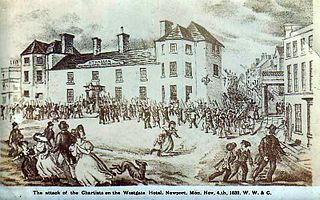
A barracks is a building or group of buildings built to house soldiers. The English word comes via French from an old Catalan word "barraca" (hut), originally referring to temporary shelters or huts for various people and animals, but today barracks are usually permanent buildings for military accommodation. The word may apply to separate housing blocks or to complete complexes, and the plural form often refers to a single structure and may be singular in construction.
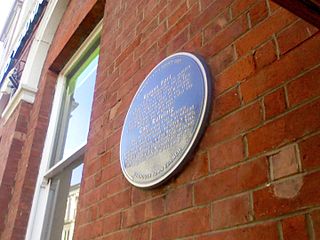
Blestium was a small fort and iron working centre in the Roman province of Britannia Superior, part of Roman Britain. It has been identified with the site of the later town of Monmouth in south east Wales, located adjoining the confluence of the River Monnow with the River Wye. A plaque on the local bank records its position.

The Mansion House was the official residence of the Mayor of Newport, South Wales until 2009. In addition to being the Mayor's official residence, it also offered hospitality and accommodation to official visitors to the city from overseas.
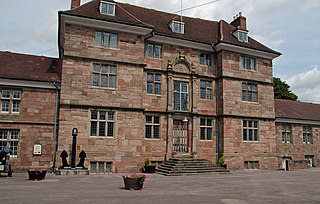
Great Castle House is a former town house built on the site of part of Monmouth Castle in Wales. Amongst the town's most significant buildings, it has a Grade I listing and is one of 24 sites on the Monmouth Heritage Trail. The house is located on Castle Hill, off Agincourt Square in Monmouth town centre.
The Monmouth Heritage Trail is a walking route which connects various sights in the town of Monmouth, Wales.
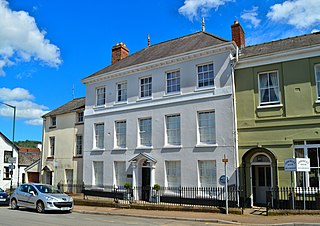
The Dispensary is a Georgian town house which is fairly typical of many town-centre houses in Monmouth, Wales, dating from the mid 18th century, but with early 19th-century additions. It stands in St James Square, opposite the Catalpa tree. The building was listed at Grade II on 27 June 1952.

The Savoy Theatre is a theatre and cinema in Church Street. It is a landmark of Monmouth, south-east Wales, a traditional county town of some 9,000 residents. It is a Grade II* listed building, which was refurbished in 1928 in traditional style, and is reputedly the oldest working theatre site in Wales. It has a capacity of 360 seats and is now run by a charitable trust. It is one of 24 buildings on the Monmouth Heritage Trail.

St Mary's Roman Catholic Church, in St Mary's Street near the centre of Monmouth, is the earliest post-Reformation Catholic public place of worship to be permitted in Wales. The church is a late Georgian Roman Catholic church with later Victorian additions by the Catholic convert architect Benjamin Bucknall. It has been designated as a Grade II listed building since 15 August 1974, and is one of 24 buildings on the Monmouth Heritage Trail.
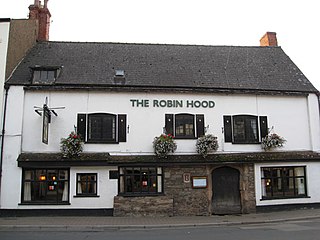
The Robin Hood Inn, Nos. 124 and 126, Monnow Street, Monmouth, Monmouthshire, Wales is a public house of late medieval origins. It was Grade II* listed in 1952.

The Market Hall, Priory Street, Monmouth, Monmouthshire is an early Victorian building by the prolific Monmouth architect George Vaughan Maddox. It was constructed in the years 1837–39 as the centrepiece of a redevelopment of part of Monmouth town centre. After being severely damaged by fire in 1963, it was partly rebuilt and is now the home of Monmouth Museum. At the rear of the building are original slaughterhouses, called The Shambles, opening onto the River Monnow. The building is Grade II listed as at 27 June 1952, and it is one of 24 buildings on the Monmouth Heritage Trail. The Shambles slaughterhouses are separately listed as Grade II*.

Hyam's Mineral Water Works is a nineteenth century building at 23 Glendower Street, Monmouth, Wales. Formerly a mineral water works, it is currently used as residential apartments. The building holds one of the 24 blue plaques awarded by the Monmouth Civic Society to buildings of especial historical and social interest, and features on the Monmouth Heritage Trail.

The White Swan Inn, White Swan Court, Church Street, Monmouth, Monmouthshire, south-east Wales is an eighteenth-century former coaching inn. The building is Grade II* listed as of 27 June 1952. It is one of 24 buildings on the Monmouth Heritage Trail.
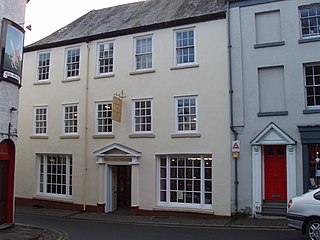
The Angel Hotel, Church Street, Monmouth, Monmouthshire, south-east Wales is a Grade II listed building. The building was in use as an inn in 1700 and closed in 1985, the longest period of continuous history of any public house in Monmouth. The building is of three storeys, with a roof of Welsh slate and a wooden Doric doorcase. During the late nineteenth century, the hotel was the headquarters of the Monmouth Branch of the Cyclists Touring Club. It is now a furniture shop, and one of 24 buildings on the Monmouth Heritage Trail.
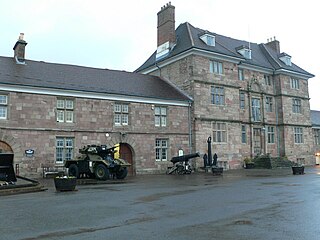
The Monmouth Regimental Museum is located on Castle Hill in Monmouth, Monmouthshire, Wales. The museum is in a wing of Great Castle House, a listed building on the Monmouth Heritage Trail. The focus of most of the museum's exhibits is the most senior regiment in the British Territorial Army, the Royal Monmouthshire Royal Engineers. Great Castle House is home to the Royal Monmouthshire Royal Engineers, and the museum maintains the records of the regiment.

Whitecross Street is a historic street in the town centre of Monmouth, Monmouthshire, Wales. It was in existence by the 15th century, and appears as Whit crose on the 1610 map of the town by cartographer John Speed. It runs in an east-west direction, between Church Street and St James Square. It has been suggested that the street takes its name from a plague cross. Whitecross Street is lined with numerous listed buildings.

St James Square is a historic square in the town centre of Monmouth, Monmouthshire, Wales. It is located at the eastern end of Whitecross Street, within the medieval town walls. The area features the Monmouth War Memorial and the controversial, historic Indian Bean Tree. In addition, in 2010, the square was the site of discovery of the first Mesolithic artefacts in Monmouth. St James Square is lined with numerous listed buildings.

Glendower Street is a historic street in the town centre of Monmouth, Monmouthshire, Wales. It extends to the southeast from the intersection of Agincourt Street and St John's Street, within the medieval town walls. Glendower Street is lined with numerous listed buildings, including one of the 24 blue plaque buildings on the Monmouth Heritage Trail.

Wye Bridge Ward was one of four wards in the town of Monmouth, Monmouthshire, Wales. Streets in the ward included St Mary's Street, Almshouse Street, St James Street, St James Square, Whitecross Street and Monk Street. The ward existed as a division of the town by the early seventeenth century, and continued into the twentieth century.






